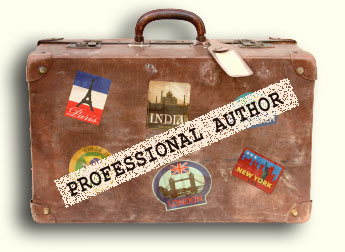Like stickers on a well-traveled suitcase, labels help us announce our achievements to the outside world: Olympic Sailor. Boat Owner. Writer. Editor. New Englander.
When I received the first royalty check for my third book, Game of Sails: An Olympic Love Story, I added a new label to my persona: Professional Author. That’s a big step up from Writer. It tells the world (and me) that I’m more than a one-hit wonder.
What I didn’t realize is that such a serious self-label would also demand a change in my writing habits. You see, before they start writing, Professional Authors make an Outline. They file a literary float plan that announces the route, schedule, and intended destination of their next story to the outside world.
I know, I know, not everyone works that way. But now that I’d dubbed myself a Professional Author, I figured I’d better outline the next book. I couldn’t just sit down and start writing—that would be so unprofessional!
I also figured it would be more efficient to know where we were headed. Writing had always meant following my characters down meandering creeks that diverged from the main channel, typing furiously just to keep up. On slow days I would prod my characters to “do something,” because I really wanted to know what happened next.
Somehow they always led me to the end of the story. And then I’d go back and delete all the dead end meanders so the final chapter seemed obvious.
This time, I’d start with an outline. How hard could it be? I had all the necessary tools right at my fingertips. Scrivener placed a corkboard full of index cards right on my screen, ready to be filled in with plot points. Best of all, doubleclicking on each index card brought up a clean white sheet of “paper” where I could add any details—or even jot down the bare bones of a scene. When I found a web page or photo I wanted to save with the project, I added it to the research folder on the fly. What a great piece of software.
When I needed another look at the big picture, MindNode provided a non-linear approach to brainstorming. And researching a location or particular era was easy, thanks to web searches and the local library.
Over a few months, I managed to come up with rough draft of an outline, my story’s float plan. I could smell the salt air and hear the voices of the main characters, so I figured I’d reward myself by pushing off from shore—writing down scene one.
And that’s when my story drifted onto the rocks.
As soon as I introduced him, Character #1 veered off from the main channel and headed down a meandering dead end creek. Hmm.
Determined to stick to the Plot, I dragged him back onto the page to meet Character #2. When she trounced off in a huff (instead of beginning the pivotal conversation that would set up the next scene), I threw up my hands in frustration. It was a battle of wills, and these two figments of my imagination were winning.
I’ve spent the past two weeks away from my writing, and sometime during that break I came to a decision: no more plotting. No matter how efficient it might seem or what I call myself, outlining obviously doesn’t work for me.
So if your own float plan takes you down a meandering creek some day soon, and you happen to see an Olympic Sailor/Writer/Editor/Professional Author aground in the marsh—don’t worry. I’m just following my characters. And eventually, they will lead me back to deep water.